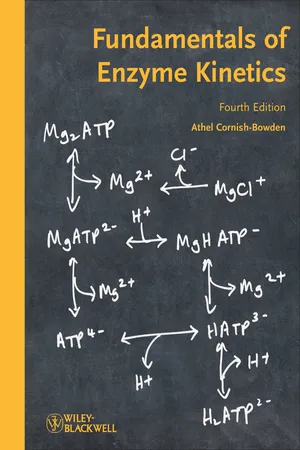
- English
- ePUB (mobile friendly)
- Available on iOS & Android
Fundamentals of Enzyme Kinetics
About This Book
Now in its fourth edition, this textbook is one of the few titles worldwide to cover enzyme kinetics in its entire scope and the only one to include its implications for bioinformatics and systems biology. Multi-enzyme complexes and cooperativity are therefore treated in more detail than in any other textbook on the market.
The respected and well known author is one of the most experienced researchers into the topic and writes with outstanding style and didactic clarity. As with the previous editions, he presents here steady-state kinetics and fast reactions, supplementing each chapter with problems and solutions. For the first time, this edition features a companion website providing all figures in colour
www.wiley-vch.de/home/fundenzykinet
Frequently asked questions
Information
Chapter 1
Basic Principles of Chemical Kinetics
1.1 Symbols, terminology and abbreviations
Table of contents
- Cover
- Table of Contents
- Related Titles
- Title
- Copyright
- Preface
- Chapter 1: Basic Principles of Chemical Kinetics
- Chapter 2: Introduction to Enzyme Kinetics
- Chapter 3: “Alternative” enzymes
- Chapter 4: Practical Aspects of Kinetics
- Chapter 5: Deriving Steady-state Rate Equations
- Chapter 6: Reversible Inhibition and Activation
- Chapter 7: Tight-binding and Irreversible Inhibitors
- Chapter 8: Reactions of More than One Substrate
- Chapter 9: Use of Isotopes for Studying Enzyme Mechanisms
- Chapter 10: Effect of pH on Enzyme Activity
- Chapter 11: Temperature Effects on Enzyme Activity
- Chapter 12: Regulation of Enzyme Activity
- Chapter 13: Multienzyme Systems
- Chapter 14: Fast Reactions
- Chapter 15: Estimation of Kinetic Constants
- APPENDIX: Standards for Reporting Enzymology Data
- Solutions and Notes to Problems
- Index
- End User License Agreement